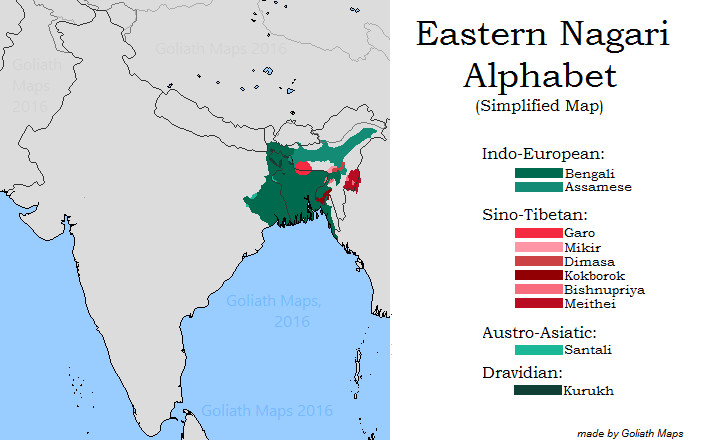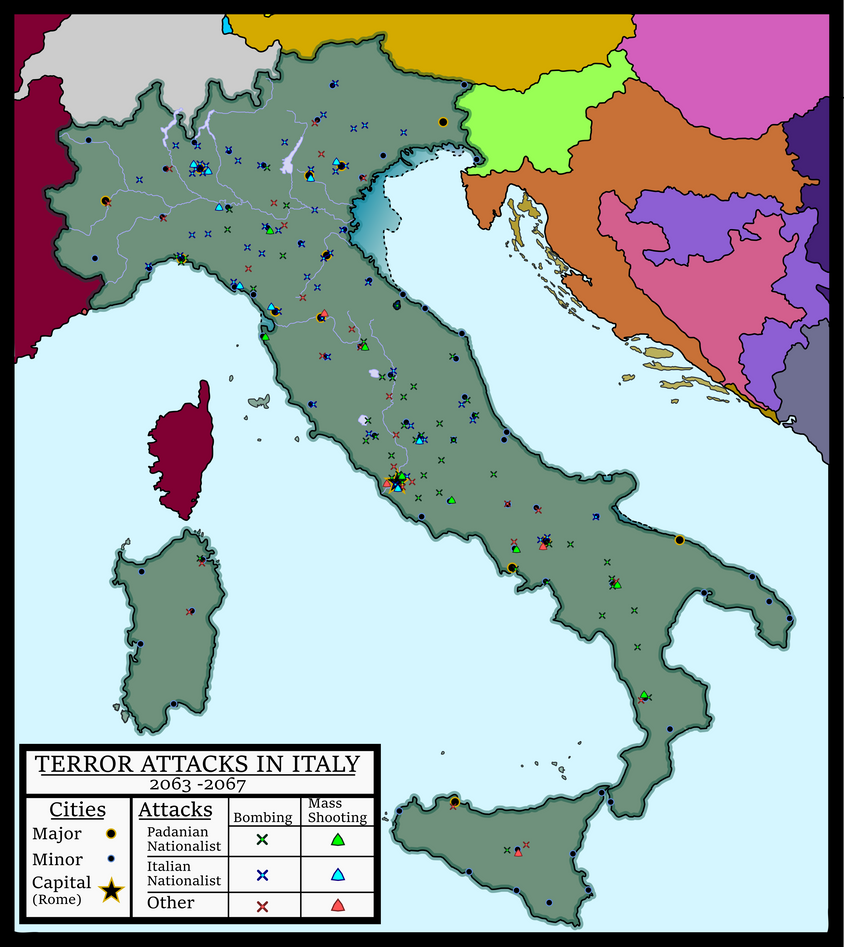Glad to see you're still making maps!
Here's another Real World Indian Alphabet Map for you;

The 19th Century saw major standardization of the Devanagari system. As late as the early 20th century, five of the of the Devanagari Alphabet had different forms in Marathi (and some of the Southern Hindi Belt Languages such as Malvi) than in standard Hindi. In most places, fonts were sometimes different- say, the difference between antiqua and fraktur fonts in Europe (https://upload.wikimedia.org/wikipedia/commons/7/73/Scripts_in_Europe_(1901).jpg), but this was an essentially artistic, or aesthetic difference that didn't actually impede on reading. The various fonts and regional discrepancies were first ironed-out by the 19th century writers, and then standardized even further in the independent India that came about after 1947.
This would have happened to Bengali as well, which, like several other languages in Eastern and North-Eastern India uses the 'Eastern Nagari' Alphabet, if it weren't for a few sound changes in all of these languages. The 'y' sound became pronounced like the 'j' sound (even in some of the Eastern dialects of Hindi this is the case- the Yamuna river is often also called the 'Jamuna' river). The 'v' sound became pronounced like 'b' (even the original Sanskrit name for Bengal is 'Vangala'). And most significantly, the short 'a' sound in Indian languages (pronounced like 'a'bout) became a short 'o' (Namashkaaram, the Sanskrit 'hello' is Namaskaar in Hindi but Nomoshkaar in Bengali and Nomoxkaar in Assamese). There's several other smaller changes to, but what I'm getting at here is that the letters may stylistically look similar enough to Devanagari to squint and guess, but that often times mean totally mispronouncing a word. And the so, 'Eastern Nagari' became considered a fully separate alphabet (treating Devanagari as the western other).
The biggest language written in this script is Bengali. Already the 7th most commonly spoken language in the world, and soon to overtake Russian making it the 6th (!!!), Bengali is the language of Bangladesh as well as the Indian states of Tripura (East of Bangladesh) and West Bengal. Bengal was partitioned (as Punjab was in the West) between Hindu and Muslim parts. The majority of Bengalis live in Bangladesh, but the largest and most developed city of the area, Calcutta or Kolkata, lies in India. While there certainly was violence and destruction as a result of that here, it was nothing like in the west (though that's a bit like saying World War I wasn't as bad as World War II) and the Bengali community became friendlier due to Indian support for Bangladesh in its war for independence from Pakistan. Bengali has a rich literary history, and Bangladesh is one of the few Muslim countries to never use the Arabic alphabet.
Though Bengal (the name for both the Indian and Bangladeshi parts of the country) considers itself the last stop in Hindustani civilization eastwards, Assam views itself as the last stop. Assamese, which follows the river valley of the Brahmaputra, is the other Indo-European language of the area, which also has a long literary history of nearly a thousand years. It is the eastern-most Indo-European language. Whereas most of India has experienced foreign invasions originating out of the west, (Persians, Scythians, Greeks, Huns, more Greeks and Persians, Timurids, Afghans, Mughals) Assam has uniquely experienced invasion and conquest by peoples to the east- the Thai Ahom Kingdom. Unlike later western conquerors (who enforced Islam), the Ahom already followed one Indian religion (Buddhism) and were happy to convert to the Hinduism of the masses they ruled- neverthless they left their mark on the language. Assamese experienced a mass boom in later half of the 20th century- while Bengali had long served as a lingua franca for the hundreds of languages of North East India, the loss of Bangladesh shifted power to Assam. For a time, as various groups in North-East India advocated for an independent state, Assamese served as the collective language of these wholly unrelated peoples. Nevertheless, since such movements have mostly been extinguished, the wider inter-late lingua franca amongst these states is now a competition between English (preferred by Christians) and Hindi (preferred by everyone else).
As a general rule, in areas of North East India where either Hinduism or Islam have a slight numerical edge, the Eastern Nagari Alphabet is used. Christianized areas used the Latin Alphabet. Buddhist areas use either the Tibetan or Burmese alphabets (depending on which they're closer to). This is a vast oversimplification- a least a handful of ancient scripts survive in common usage within individual areas (the Chamki for instance, are a people about 300,000 who live in South-Eastern Bangladesh are continue the Buddhist religion and their own unique alphabet despite official discrimination), and several modern inventions are used as well. But I'm trying to simplify things
While Bengali and Assamese are the only two 'Literary' languages of the area, two other languages are following suit, with new larger 20th century literary works. Garo, spoken in the western half of Meghalaya, is home to the only truly active Independence insurgency in India (there are other "freedom fighters/terrorists" of course, but they're mostly a few dozen teenagers hiding in a jungle hut with a pickup truck and a shared AK).
Bengali Hindus began experiencing increased pressure under Muslim rulers in the early 1700s, and to strengthen their religion began mimicking the missionary practices of Imams and Pastors and began proselytizing their particular brand of Hinduism in the lands to the east- in the Kingdom of Manipur this was taken up by the Meithei and Bishnupriya people. In Manipur today, Hindus remain with a very small numerical advantage over the Christians, unlike a few other states in the North-East.
Like Ahom, Kokborok is the language of an alien people who came from the east and created their own Kingdom- Tripura. The majority of the people in Tripura still spreak Bengali though.


